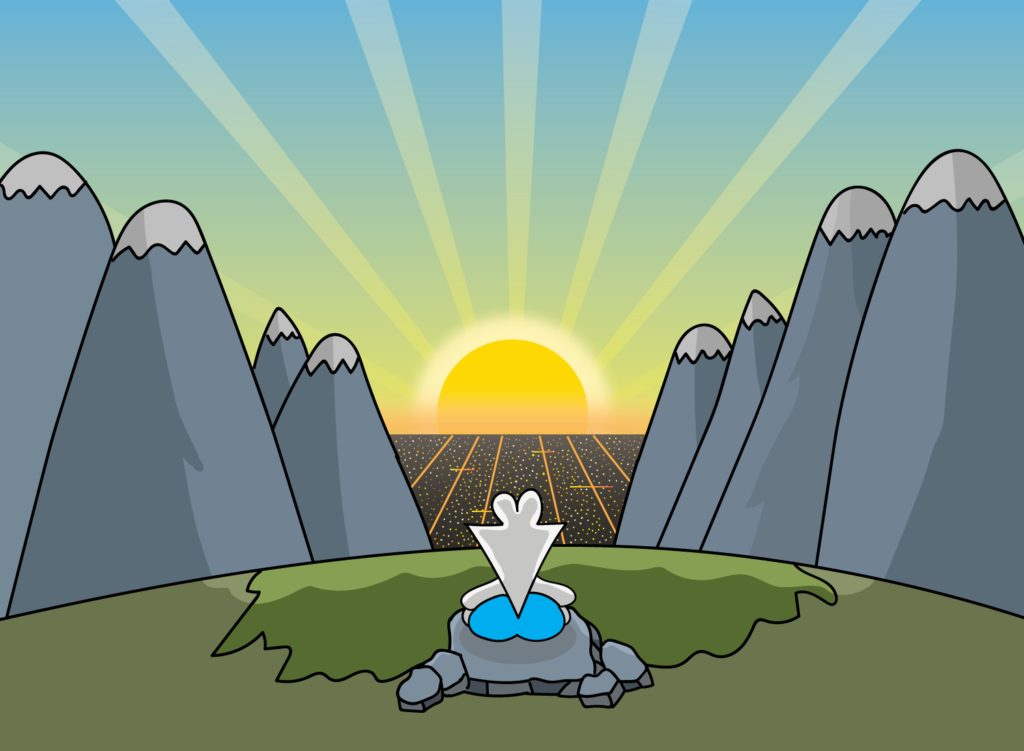Welcome to this edition of the Mindful Makers interview series, where we go behind the scenes with prolific creators and explore what makes them creative and productive. I’m incredibly excited to chat with Lawrence Yeo, the writer and illustrator of More To That, a blog that delves into what makes humanity so fascinating.
I first discovered Lawrence through his illustrated article The Meaning of Life is Absurd, which I shared exactly a year ago in the second edition of the newsletter. I immediately fell in love with the thoughtfulness and playful curiosity of Lawrence’s work.
And I’m not the only one—his work has been read more than 1.5 million times. One of his pieces, Travel Is No Cure for the Mind, is one of the most popular articles ever published on Medium.
“Life as a human is a weird experience, but one that I’m very grateful to be a part of. And when you have a sense of gratitude for the peculiar, you get a little something called curiosity,” Lawrence explains on his website, where he writes about philosophy, psychology, creativity, and anything that explores the nuances of the human condition. This sense of awe is at the heart of what makes reading Lawrence’s articles so enjoyable and thought-provoking.
In this interview, we discussed turning loose ideas into a cohesive structure, building creative sandcastles, using visuals to convey ideas, the nuances of reality, the relationship between curiosity and uncertainty, investing into the unknown, live feedback loops, trusting your personal experience, and much more.
Lawrence was also kind enough to create original illustrations for this interview—enjoy!
Lawrence, thank you so much for agreeing to this interview. You’re a man of many talents. You write, you create illustrations, and you also have a YouTube channel. Is there a medium you feel more comfortable with?
Glad to do this interview, Anne-Laure! I’m a fan of Ness Labs, so I’m excited to be here.
Writing represents the core of the creative process for me. If I were to visualize it, writing would be the sandbox for all my ideas:
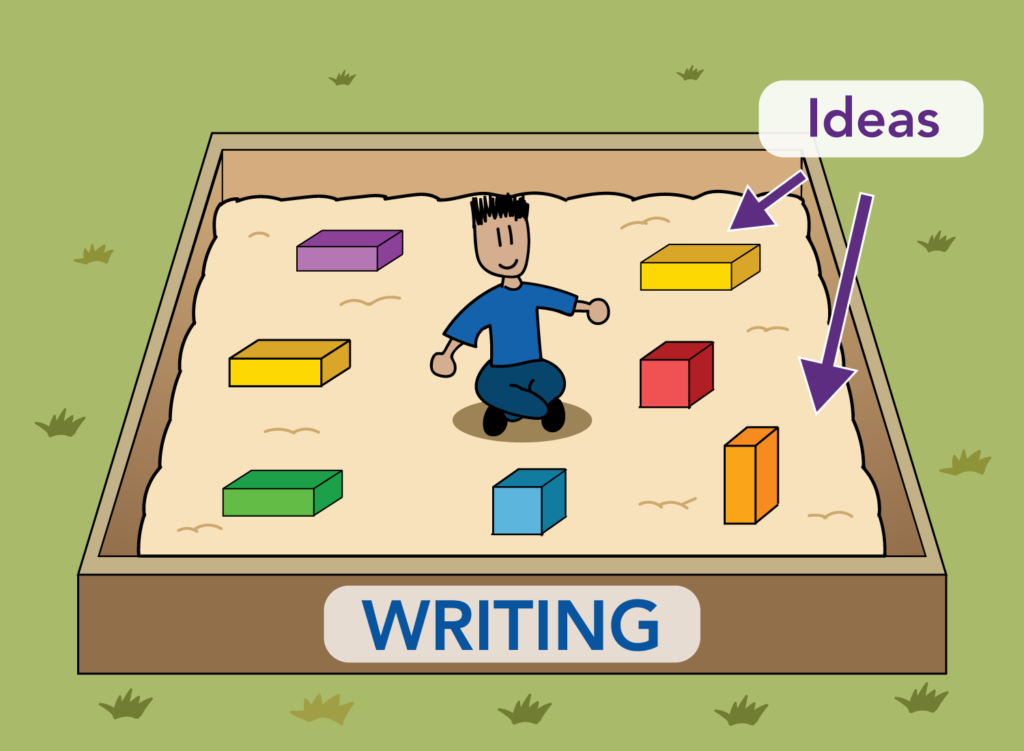
Since ideas tend to be disjointed and come from all over the place, it can be hard to know what exactly you think about any given topic. Writing gives me the space to put those idea blocks together and form something concrete and recognizable. Creativity is ultimately about taking what is already accessible, and shaping it into something that is unique to your personal experience and worldview. For me, writing is the starting point of the creative process because it clarifies how I want to approach any given idea.
Once I finish writing, I have structured the various loose ideas into a somewhat cohesive structure that I can point to as a guide for my thinking.
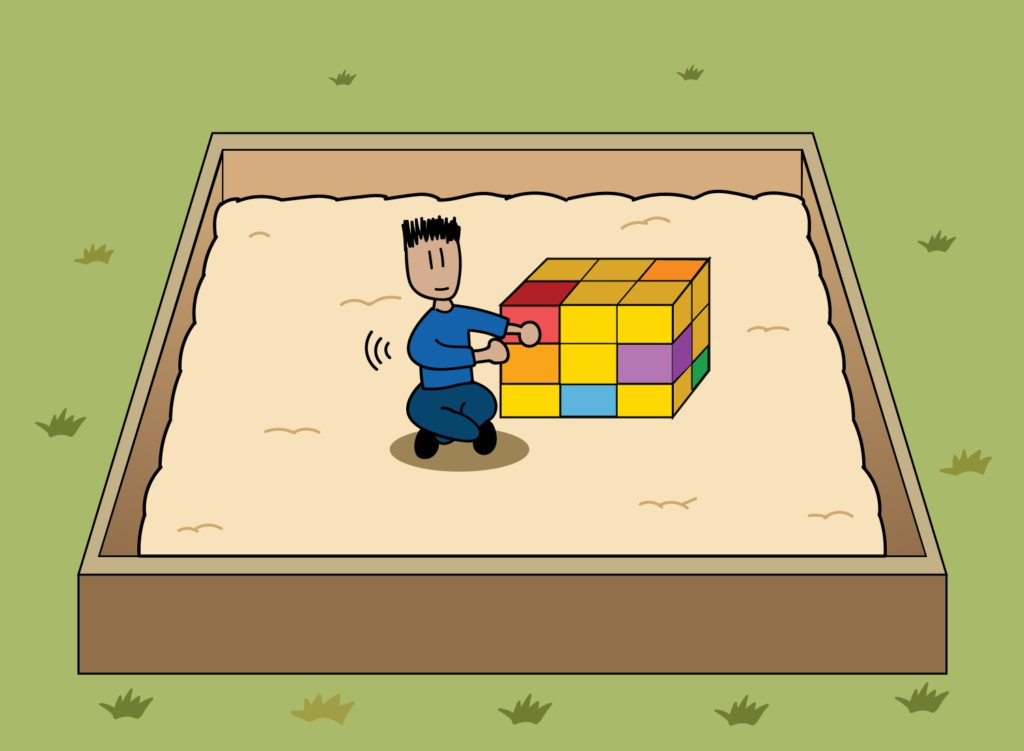
This structure is coherent to me, but the next thing I enjoy doing is making it fun and recognizable for the reader. This is where my own preferences come in. I enjoy reading things where chunks of text are broken up by images—whether they are charts, drawings, anything. It makes the learning process more fun, and I find it engaging.
This is why I use illustrations to provide visual cues to my writing. Not only does it make the body of work more enjoyable, it also forces me to simplify the concept at hand even further. I’ll try to use an analogy to make the concept stick, or condense it into a diagram that can be easily interpreted.
So in my creative sandbox, I will start with the idea structure I built through writing:
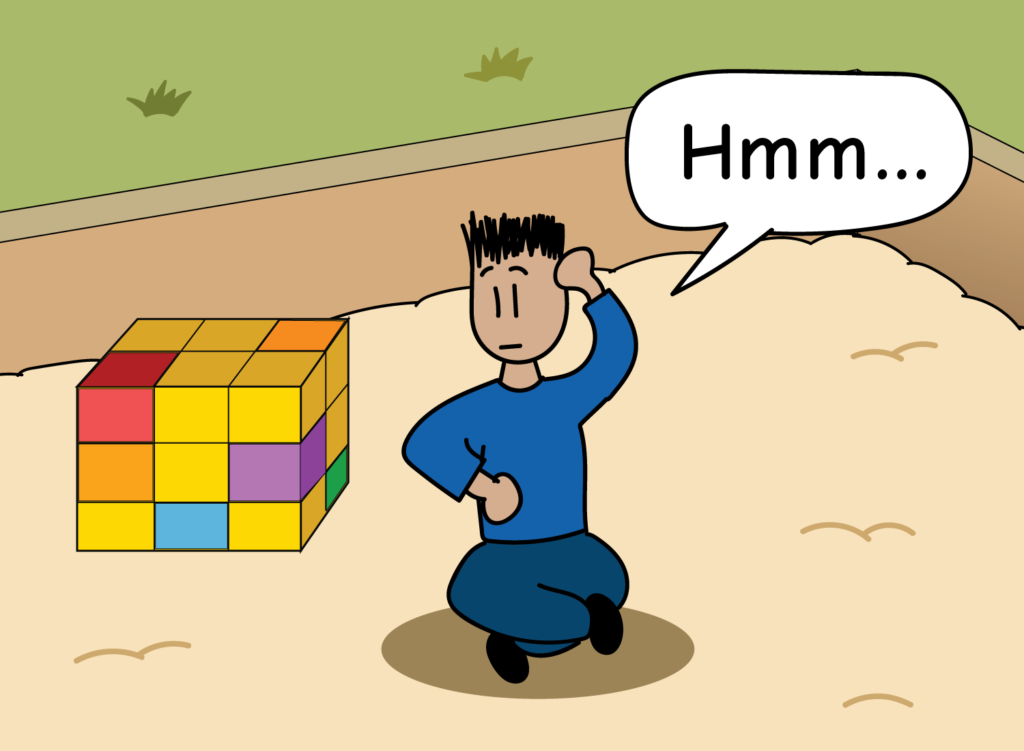
Then I will use illustrations to convert it into something recognizable that the reader could remember well after the post has been read:
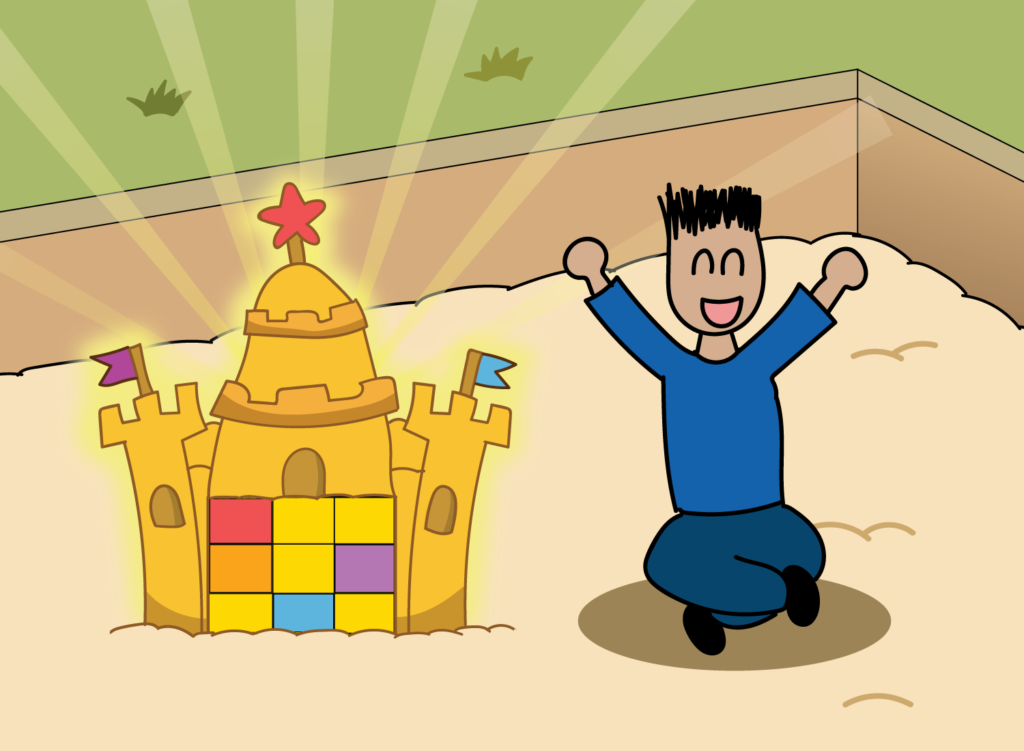
These sandcastles and other recognizable things would be the drawings I make to personify my thoughts. But without the sandbox of writing, there wouldn’t be a home for them in the first place.
Interestingly, the way I answered this question is like a mini-example of how a More To That post would work! I use writing to structure and convey my thinking, then use illustrations to make those concepts stick.
I love how meta this answer got! Is there a medium you would like to explore further beyond writing and illustration?
The next format I’m looking to explore deeper is audio, as I enjoy talking with other people and bouncing ideas back and forth. Despite that, writing remains central to how I challenge, understand, and construct my worldview.
Audio is such an interesting format. Going back to your current content, your most popular article is called: “Travel Is No Cure for the Mind.” I personally found you through the one called: “The Meaning of Life Is Absurd.” Did you notice a pattern in terms of what people seem to enjoy learning about, or does it feel random to you?
It feels a bit random to me, but I think that’s because my work doesn’t really fit nicely into any particular niche. In fact, I don’t really even know how to categorize my work! When people ask me what I write about, I tend to just say that I write about philosophy, psychology, and creativity, but I’ve also written about the neuroscience of anxiety disorders, taking life leaps, and why weddings are great. The only common thread running through them seems to be my curiosity.
Based on popularity alone, people seem to enjoy learning about (1) how meaning is cultivated and internalized, and (2) some of the tools humanity has created to solve for #1. For example, my post on money and identity has been widely read, and it’s an exploration of how money acts as a crude tool to claw our way toward happiness. I like exploring the tension we create when we use crafty workarounds to solve for the deepest questions, and how they almost always result in paradoxical conundrums that confuse us even further.
For example, money can buy the freedom required for happiness, but it won’t buy you happiness itself. Travel will bring you to amazing places, but a restless mind travels with you wherever you go. We are all aware of our finiteness, but we set goals because we expect a new morning to await us each day.
Reality is far more nuanced than we believe it to be, and we only have the lenses of our personal experiences to view it through. I think readers like exploring how we could better fit that lens, and how it could be used to see things for what they really are. But since nothing is certain, the pursuit of the question is far more interesting than the answer. Readers seem to like the posts that walk this fine line of exploration and discovery with me.
That’s interesting—some of my most popular articles are about time anxiety and being too busy to enjoy life, so I guess there may be lots of value in content that explores such paradoxes. You once wrote: “When you have a sense of gratitude for the peculiar, you get a little something called curiosity.” Can you tell us a bit more about how you cultivate your curiosity?
Curiosity is driven by the relationship you have with uncertainty.
If uncertainty scares you or makes you feel insecure, then the desire to explore is cut at the root. You will hold onto the small bubble of certainty you’re in, and will minimize any effort to look outside it.
But if uncertainty intrigues you, then you are willing to drop what you know at the door and delve into uncharted territory. It’s the acceptance of the belief that there’s so much out there, and that you’d be happy to update your thinking based upon what you find.
The key to cultivating curiosity is to have a healthy relationship with uncertainty. Practically speaking, this can be accomplished by engaging with both dissenting and assenting views of my beliefs, whether it’s through reading various authors or listening to different viewpoints. However, I’m only human, filled with my cognitive biases and all that good stuff. I’m prone to siding with the views that align with the ideas I value.
“The key to cultivating curiosity is to have a healthy relationship with uncertainty.”
Lawrence Yeo.
I think cultivating curiosity is less about practicality, and more about poignancy. Instead of ensuring that I methodically hear all sides of an argument, I just commit myself to exploring whatever sounds remotely compelling. By compelling, I don’t mean whatever sounds good to me. By compelling, I mean whatever I don’t know enough that I would like to invest my time in.
After all, curiosity is also a time investment into the unknown. There is only so much of the vast unknown you could tap into in one lifetime, so it’s important to explore something you feel is worthwhile. Sure, I don’t know enough about Flat Earth theory to methodically dispute it, but at the same time, I just don’t care. There are far more interesting problems for me to look into while I have this time in this world.
As long as I’m grateful for the problems I want to explore, curiosity will be there to guide me through it.
That makes sense. Curiosity is such a good radar to decide what problems to explore. But for highly curious people, it can still be overwhelming to decide what unknowns to invest in. More specifically, how do you go about finding and selecting ideas to write about and illustrate for your blog?
I find and select my ideas through three primary channels:
- One-way transmissions
- Live feedback loops
- The well of personal experience
The one-way transmissions are the sources of information we are most familiar with. These are books, blogs, videos, and podcasts that are broadcasted from one creator to a wider audience. There is a wealth of knowledge in these sources, and if something resonates, I will take notes in the margins of a page, highlight passages in Kindle, or make a mental note to revisit a section of something I heard. I’m a bit old-school here in that I take a lot of my notes in longhand (and even outline many of my posts this way too). Recently I’ve started exploring some note-taking tools as I find the idea of networked thought compelling (you’ve evangelized this quite well!), and I’ll see if it may be a good fit in this realm.
The next channel of idea discovery comes from live feedback loops I have with others. While one-way transmissions are great, interaction isn’t fostered because I can’t engage with a podcast host or talk to an author who passed away decades ago. There is something special about bouncing ideas back and forth with another person that encourages serendipity and creates epiphanies. It takes the ideas you’ve developed in your sandbox, and allows them to interact with those in another creative playground.
This mixing and mashing of thoughts and experiences is quite exciting to me, and I think there’s something special about doing it synchronously. While asynchronous communication has become the new normal, it feels somewhat rigid at times, and misses a lot of tangents and realizations that come with dialoguing in real-time. Of course, asynchronous communication is wonderful in that it has vastly expanded our ability to reach others and connect, but if you really want to interact with another person’s ideas and see how your worldview fits, then a live feedback loop is difficult to beat.
Finally, many of my ideas come from the well of personal experience. This is perhaps the most overlooked treasure trove for writers and creators. The difficult thing about information abundance is that it has conditioned us to look toward outside sources to validate our thoughts. There will always be some quote from some accomplished person that justifies your take on a topic. Or some double-blind psych study that validates a belief you hold.
I don’t undermine the validity of expert opinion, but it’s important to have confidence in what you have experienced yourself as well. For example, I often struggle with self-doubt, and have reflected enough on this topic to develop a personal framework of how I could overcome it. Aside from a short Bertrand Russell quote, everything I wrote on self-doubt in this post comes from my own experiences with it.
When a reader decides to read your work, they are going into it with the mindset that they want to hear your unique take on a subject. So it’s okay to blend what you’ve learned with how you feel about it, and present that insight to your audience. Chances are they’ll enjoy your work more after you’ve injected some of your experiences into it.
This is great advice. That’s why I make sure to spend time away from my computer when I want to think. If I’m online, I will tend to go and check an expert’s opinion without leaving enough time to develop mine. Freely exploring my thought processes has been one of the biggest benefits of writing on Ness Labs. What about you—what has been one of the biggest benefits, or one of the nicest experiences you’ve had as a direct result of running More To That?
Working on More To That has been such a privilege. Not only do I get to write about whatever interests me, I get to regularly hear from people that viscerally relate to these topics, or have found the work helpful.
Perhaps the biggest benefit is understanding that I’m not alone in my finite search to uncover what’s real. My work is mostly about delving deeper into the nuances of the human condition. To parse through the illusions we may have set up to distract us from the issues that really matter. Before starting More To That, I didn’t have the proper conduit to express these thoughts, and I didn’t do the necessary work to structure them in a cohesive way.
But working on the blog helped me understand there were many other people that were on a similar search. And amazingly, they saw More To That as one of the tools they could use to parse through some big questions in their own lives as well. Some of the emails I get from readers are deeply personal, things they would probably never divulge to a person they just met for the first time. However, through reading the blog, perhaps they are able to feel a personal connection to me, and it’s familiar enough for them to reach out and say hello.
I try to keep this in mind whenever I get an email from someone. That on the other side of this inbox is a human being with an unbelievably interesting story, a unique set of circumstances that have somehow led them to compose an email and send it over to a person they don’t even know. The likelihood of that happening is so improbable, yet that’s exactly what happened.
Keeping this in mind makes every interaction a precious one. Being able to experience this somewhat regularly is what makes this endeavor so worthwhile.
Connecting with an audience of like-minded people is probably one of the most beautiful aspects of being a creator. What advice would you give to someone who wants to start creating online content and who’s not sure where to start?
It’s amazing how every creator you could think of started with no audience. The greatest legends of any craft started from the plateau of indifference. Sometimes that reality is hard to imagine, but it’s the truth.
Given this, the question of creating can’t start with an audience. This is one of the most important things to understand when starting out. You are both the creator and the audience of your own work. You must make the things that you’d want to engage with yourself.
This is why personal tastes and interests are the best creative compasses. If you want to write online, what kind of stuff do you enjoy reading and learning about? Do you like long-form stuff, or shorter pieces? Do you like it when drawings are included? If you didn’t write what you just wrote, would you still want to read it?
Creativity is about making the things you want to see in the world. After all, inherent in the desire to create is that there’s a void you want to fill. It may be a tiny one that only you think you care about, but you’d be surprised at how many other people might care about it too.
When starting out, look within. Make the things that resonate with you. It’s the only way you’ll get something that feels authentic, and is the only way to work on it sustainably. You can only emulate someone else for so long before it gets tiring.
The only way to create energetically is to be yourself.
Thanks so much, Lawrence! Where can readers learn more about your work?
@moretothat for the blog, @treblesandblues for the music. Music is another important part of my life, and while I’m not active at the moment, I make beats that span a multitude of genres (hip hop, house, funk, and more). And here is one of my favorite illustrations:
